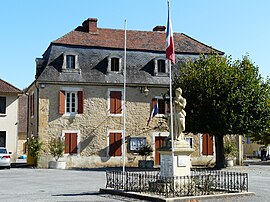Mauzac-et-Grand-Castang (French pronunciation: [mozak e ɡʁɑ̃ kastɑ̃]; Occitan: Mausac e Grand Castanh) is a commune in the Dordogne department in Nouvelle-Aquitaine in southwestern France. Mauzac station has rail connections to Bordeaux, Bergerac and Sarlat-la-Canéda.
Mauzac-et-Grand-Castang | |
|---|---|
 The town hall in Mauzac | |
| Coordinates: 44°51′55″N 0°47′53″E / 44.8653°N 0.7981°E | |
| Country | France |
| Region | Nouvelle-Aquitaine |
| Department | Dordogne |
| Arrondissement | Bergerac |
| Canton | Lalinde |
| Government | |
| • Mayor (2020–2026) | Florent Farge[1] |
| Area 1 | 15.85 km2 (6.12 sq mi) |
| Population (2021)[2] | 873 |
| • Density | 55/km2 (140/sq mi) |
| Time zone | UTC+01:00 (CET) |
| • Summer (DST) | UTC+02:00 (CEST) |
| INSEE/Postal code | 24260 /24150 |
| Elevation | 35–207 m (115–679 ft) (avg. 49 m or 161 ft) |
| 1 French Land Register data, which excludes lakes, ponds, glaciers > 1 km2 (0.386 sq mi or 247 acres) and river estuaries. | |
History
editMauzac and Grand-Castang was created on 1 January 1973 by combining the former communes of Mauzac and Saint-Meyme de Rozens in the valley and Grand-Castang on the hillside.
The village has been occupied from prehistoric times, as is evidenced by numerous traces (fragments of axes, scrapers...).
Its past is closely linked with the Dordogne River, which became an important commercial and cultural route in the 18th and 19th centuries. Mauzac is one of the active ports that feed the interior of the region. Only a few vestiges of the built quay remain, just some paving stones cut in the old-fashioned way, identical to those still seen in Bordeaux. Constructions of the Canal de Lalinde to facilitate navigation for the scows, of the hydroelectric dam, and the arrival of the railway in the 19th century, changed the life of the village considerably.
Population
edit| Year | Pop. | ±% |
|---|---|---|
| 1962 | 814 | — |
| 1968 | 761 | −6.5% |
| 1975 | 688 | −9.6% |
| 1982 | 772 | +12.2% |
| 1990 | 958 | +24.1% |
| 1999 | 868 | −9.4% |
| 2008 | 845 | −2.6% |
| 2012 | 896 | +6.0% |
| 2013 | 894 | −0.2% |
| 2014 | 898 | +0.4% |
Sights and monuments
edit- The site of the theatre: On the way, the stone huts (bories), including one with a flat roof. Vine growers used them as shelters. You can see a brick oven called "the peasants’ oven" ("le four des croquants"). It is not a "communal" oven, but one of the first wood ovens used by the poor peasants called "croquants". From this site, there is a very pretty view of the town and the river.
- The current port: The construction of a scow in the style of Coureau at the beginning of the century, offers sailing trips with wine-tasting and sampling high-end products of Périgord.
- The railway bridge: This ochre stone bridge is 254 meters long. It has seven arches, each with a 30-meter opening. The distinctive characteristic of this bridge is the elliptical shape of its arches and their low height compared to their width. Its design, daring for the time, offered an important drainage duct for a given width during floods. The solution adopted was to have a minimum of piers and thus a maximum of width for the arches.
- The lake: The dam's reservoir is a splendid lake, more than 1,000 hectares, an attractive centre for fishing, sailing, rowing, canoeing and kayaking. The developed banks are a meeting place for hikers. The "ferryman’s house" has been made into a showroom. Photographs and postcards of Mauzac in bygone days are available there. Upstairs, Electricité de France (EDF) has set up an exhibit about the hydroelectric evolution, and the Fishing and Hunting Federations offer a discovery of the surrounding wildlife.
See also
editReferences
edit- ^ "Répertoire national des élus: les maires". data.gouv.fr, Plateforme ouverte des données publiques françaises (in French). 9 August 2021.
- ^ "Populations légales 2021" (in French). The National Institute of Statistics and Economic Studies. 28 December 2023.
- ^ Mauzac Town Hall: Extract from Michel A Rateau, Bulletin de la Société Historique et Archéologique du Périgord



